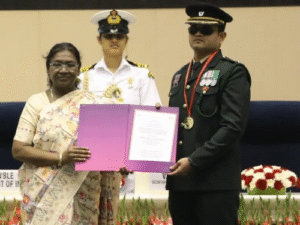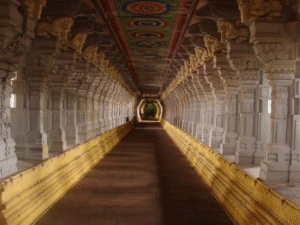C.V. Raman (Chandrasekhara Venkata Raman) made history in 1930 by becoming the first Indian to be awarded the Nobel Prize in Physics, for his groundbreaking work in the field of light scattering. He is celebrated not only as one of India’s greatest scientists but also as a pioneering figure in global scientific research.
November 7, 1888, in Tiruchirapalli, Tamil Nadu, India, to a middle-class family. His father, R. Chandrasekhara Iyer, was a teacher of mathematics and physics, which instilled in Raman an early interest in science.
Raman excelled in academics from an early age, and he completed his schooling in Chennai (then Madras). He went on to study at Presidency College, Chennai, where he earned a degree in B.A. in Physics in 1904 and later completed his M.A. in 1907.
After completing his education, Raman joined the Indian Finance Department in 1907, but he continued to pursue his interest in physics in his spare time.
His early research focused on acoustics, especially the theory of sound, and the properties of musical instruments.
In 1917, Raman became a professor of Physics at the University of Calcutta, where he had more freedom to pursue research.
In 1928, while working at the Indian Association for the Cultivation of Science (IACS) in Kolkata, Raman discovered that when light is scattered by a medium, it undergoes a shift in its wavelength. This phenomenon is called “Raman scattering” or the Raman Effect.
The Experiment: Raman used a simple experimental setup, shining light through a liquid and observing the scattered light with a prism. He found that the scattered light had different wavelengths from the original light, which was a completely new discovery in the field of optics.
Significance: The Raman Effect helped scientists understand how light interacts with molecules, and it laid the foundation for molecular spectroscopy. It also opened the doors for numerous applications in areas like chemistry, medicine, biophysics, and materials science.
In 1930, C.V. Raman was awarded the Nobel Prize in Physics for his work on the scattering of light, which came to be known as the Raman Effect. He was the first Asian and the first Indian to receive the Nobel Prize in the field of Physics.
Recognition of the Discovery: The discovery of the Raman Effect was an extraordinary achievement in the field of science, and it was seen as a validation of Raman’s innovative approach to research. It also marked a significant milestone for Indian science on the global stage.
Institute of Fundamental Research: After receiving the Nobel Prize, Raman continued his research at the Indian Institute of Science (IISc) in Bangalore and later at the Raman Research Institute (RRI), which he founded in 1948. The institute became a hub for advanced scientific research, particularly in light scattering, crystallography, and acoustics.
Contributions to Acoustics: Raman’s work was not limited to the field of optics. He made significant contributions to acoustics as well, studying the physics of sound, musical instruments, and resonance.
Research on the Nature of Light: Raman’s research was crucial in advancing our understanding of the nature of light. He worked on understanding the properties of light waves, and his insights contributed to developments in quantum theory and wave mechanics.
Bharat Ratna (1954): Raman was awarded India’s highest civilian honor, the Bharat Ratna, in 1954, for his extraordinary contributions to science.
Honorary Degrees and Positions: Raman was awarded honorary degrees from several universities across the world, and he held many prestigious positions, including serving as the President of the Indian Academy of Sciences.
Royal Society Fellowship: He was elected as a Fellow of the Royal Society (FRS) in 1924, which was a significant international recognition of his scientific contributions.
Knighthood: In 1929, Raman was knighted by the British Government in recognition of his scientific achievements.
Global Influence: The Raman Effect is one of the fundamental discoveries in modern physics. It has had a profound impact on various fields, from chemistry to medicine. It is used in applications like Raman spectroscopy, a technique widely used to analyze chemical compositions and identify substances.
Inspiration for Indian Scientists: Raman’s achievement made him a role model for many aspiring scientists in India and around the world. His work showed that one could achieve world-class scientific success even while working in less-than-ideal conditions, and it helped foster scientific inquiry in India.
The Indian Science Movement: Raman was a key figure in the development of Indian science during the early 20th century. He encouraged scientific research and education in India and promoted the idea that Indian scientists could compete globally.
Raman’s Mentorship: Raman mentored many Indian scientists who would go on to become leaders in various scientific fields, including Satyendra Nath Bose (theoretical physicist) and G.N. Ramachandran (biophysicist).
Raman believed in the importance of scientific research in promoting a nation’s development. He was also a strong advocate for the idea that basic research is vital to understanding the world.
He emphasized the importance of having a scientific temper and promoted a rational and methodical approach to solving problems.
“The true function of a scientist is not to achieve but to serve humanity” was one of his key principles.
Died: C.V. Raman passed away on November 21, 1970, at the age of 82.
Centenary Celebrations: In 1988, the centenary of his birth was celebrated across India and around the world, with numerous scientific conferences, commemorations, and research advancements in Raman’s name.
Raman Research Institute: The institution he founded in Bangalore continues to be a center of excellence in scientific research, continuing the legacy of its founder.







